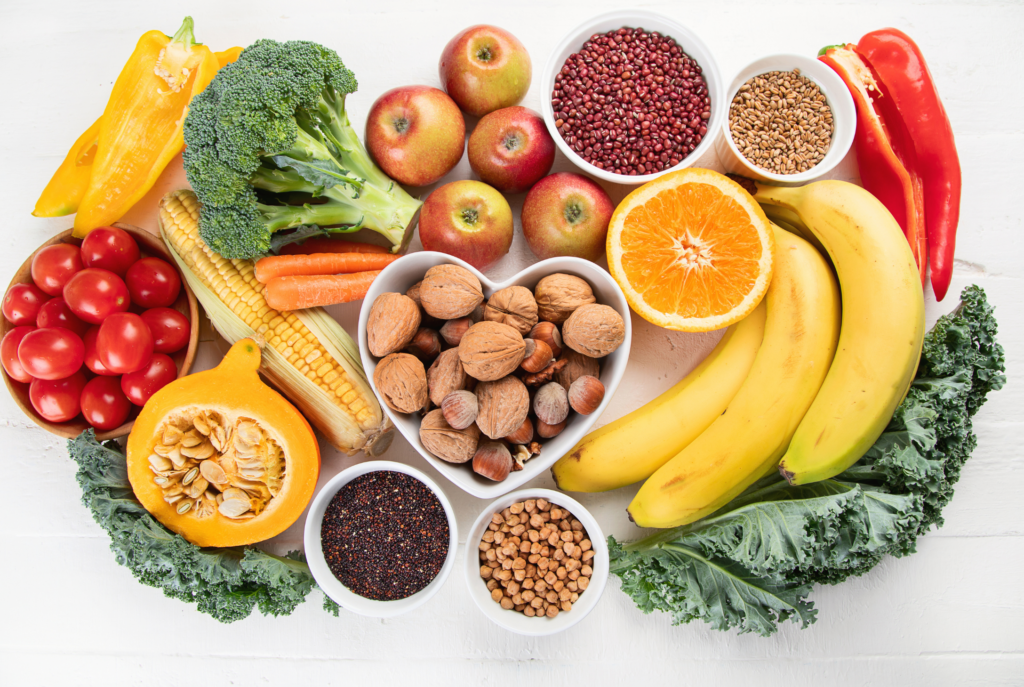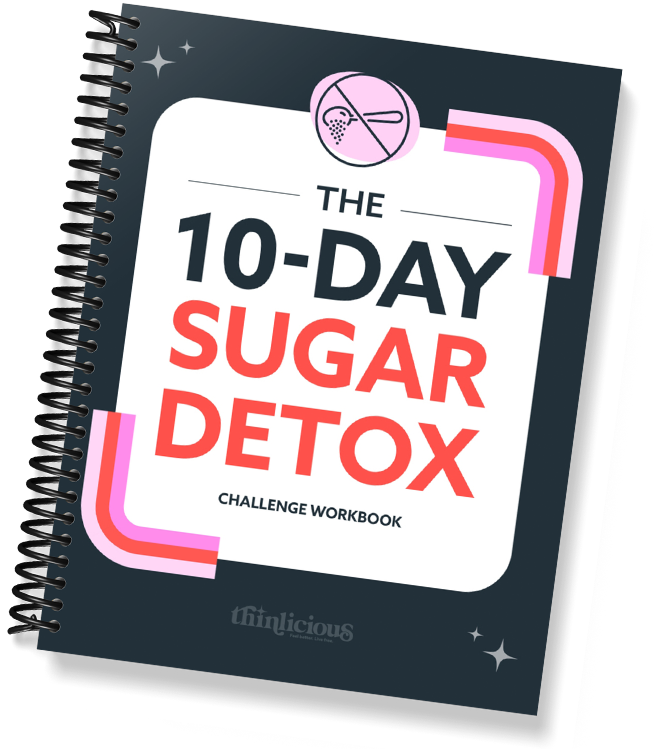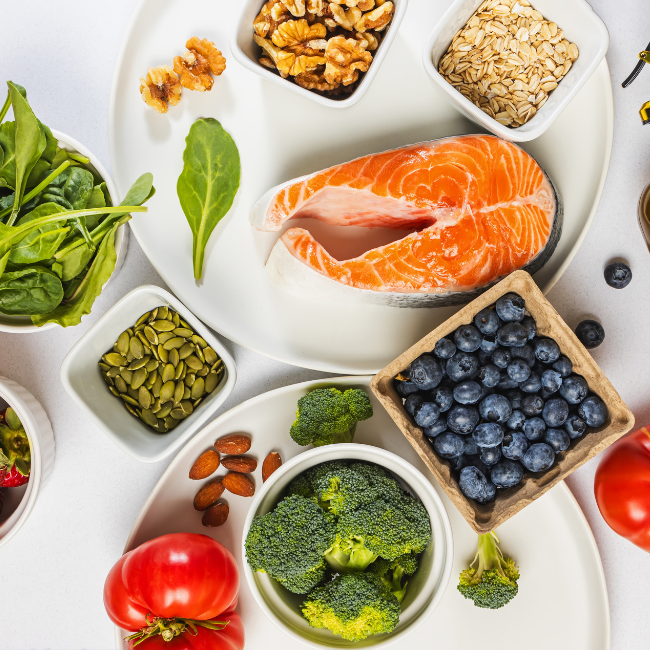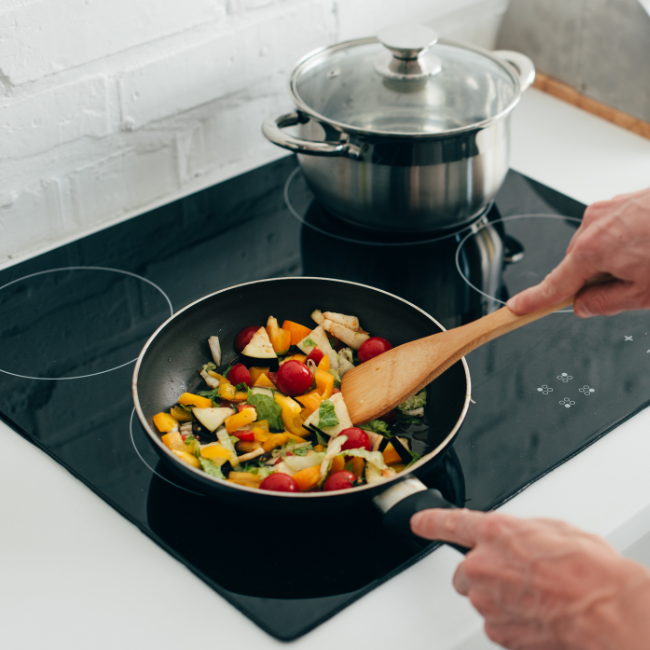What’s the first thing that comes to mind when you hear the word fiber?
It probably has something to do with either constipation or regularity, right?
And chances are, it’s probably not something you even think about on a regular basis, at least not until you’re having a little trouble going number two.
Which is why it might surprise you to know that fiber affects more than just, well, you know.
Are you ready to lose weight and heal your body for life (without dieting, drugs, or making yourself miserable)?

Our free on-demand video training will walk you through how to make this THE year you set health goals…and keep them.
And while we’ll definitely discuss constipation in this blog post, know that getting enough fiber is better for more things than just toilet troubles. Eating enough of the right kinds of fiber can affect your overall health and well-being and even heal food sensitivities. A healthy gut is linked to tons of health issues—it’s pretty surprising!
That’s why it’s so important to make sure you’re eating enough high-quality fiber every day. In this article, we’ll discuss the benefits of fiber for gut health and give you some tips on how to get more into your diet.

What Is Fiber?
Before we get into all the health issues related to fiber, let’s make sure we understand what fiber is (and what it isn’t).
Dietary fiber is a type of nutrient. It’s a type of carbohydrate that the body can’t digest or break down into sugar molecules. Instead, it passes through the body undigested.
Fiber is found in whole grains, whole fruits and vegetables, legumes and nuts. When you’re eating low carb, you’ll get your fiber mostly from vegetables.
There are two types of dietary fiber: insoluble and soluble. The difference between them is basically which kind dissolves in water. Both kinds are beneficial to your health.
Insoluble fiber doesn’t dissolve in water. It moves food through your digestive system and prevents constipation. Think of insoluble fiber as “roughage.” It includes the harder-to-chew skins on fruits and the rough exterior of broccoli.
Low-carb foods that are high in insoluble fiber include:
- Leafy Greens – kale, spinach
- Nuts – almonds and walnuts
- Seeds – sunflower seeds
- Celery
Soluble fiber dissolves in water. It helps your body lower glucose levels and is even linked to lowering cholesterol levels. During the process of digestion, soluble fiber turns into a sticky gel that attracts water, which makes stools softer and easier to pass.
Low-carb foods with soluble fiber include:
- Chia seeds
- Blueberries
- Brussels Sprouts
- Asparagus
Remember, you need both types of fiber to keep your gut healthy.
What Is Gut Health?
So, what even is gut health, and why is it so important?
Gut health is the overall condition of your gastrointestinal tract. It includes the health of your stomach, small intestine and large intestine. There is an entire microbiome in your gut that includes a bunch of different bacteria, both helpful and potentially harmful.
The balance of good bacteria to bad bacteria is what people are referring to when they talk abut gut health. Did you know that 80% of your immune system is in the gut? Yup! If your gut doesn’t have enough helpful bacteria in it, or you aren’t regular enough, it could affect how effectively your immune system works.
Gut health is essential for overall health, and a diet low in fiber can lead to problems such as constipation, acid reflux and even leaky gut syndrome (and so much more).
What is leaky gut syndrome?
One more thing we need to understand is the term “leaky gut syndrome.”
Leaky gut syndrome is a problem that can happen when the intestines get damaged. This can allow things like bacteria and toxins to escape from the intestines and into the rest of the body. It’s a pretty scary thought and painful to experience.
This can cause all sorts of problems, like diarrhea and constipation, pain and even autoimmune diseases.
Thankfully, working to prevent leaky gut syndrome (and a host of other health issues) is as easy as eating your leafy greens.
Health Benefits Of Fiber
Feeding your gut plenty of fiber will help you prevent those health issues. Both soluble and insoluble fiber are essential for your health and wellness.
Just look at all fiber can do!
Increases Regularity
Fiber bulks up your stool and makes it easier to pass through your body. It’s the solution for watery stools because it absorbs water, adding bulk. It also helps with constipation because it makes harder stools softer.
Maintains Bowel Health
Eating enough fiber is also linked to lowering the risk of hemorrhoids and diverticular disease (small pouches in your colon). And since some fiber ferments in the colon, researchers are looking at how that plays a role in preventing diseases there.
Controls Blood Sugar Levels
Soluble fiber slows down the absorption of sugar, which prevents insulin resistance. When you keep your blood sugar levels low, you’ll decrease your risk of developing Type 2 diabetes.
Lowers Cholesterol Levels
There are a bunch of studies out there linking fiber in your diet to lowering blood pressure and inflammation. It can also help lower low-density lipoprotein (LDL), or “bad” cholesterol levels.
Increases longevity
When you increase how much fiber you eat, you could reduce your risk of cardiovascular disease and even cancer. Since gut health is directly linked to your hormones and immune system, a healthy gut will help you have a better quality of life.
Linked to healing food sensitivities
“The more you heal the gut, the less allergies you’ll have” – Dr. Edie Wadsworth, MD
Here’s how Dr. Edie describes it. When you eat fewer processed foods and more whole, nourishing foods, the gut will heal itself and food sensitivities will be less of a problem.
This is because when you have an unhealthy gut, the gap junctions are wider, so things get through to the bloodstream that shouldn’t get through. When you heal the gut, it closes down, and you don’t get things in the bloodstream that cause reactions.
When you follow the Thinlicious™ plan, eating low carb, high fat and plenty of fiber, you will naturally nourish your gut without even thinking about it!
Absorbs More Nutrients
Fiber helps to promote a healthy digestive tract by slowing down digestion and helping your body absorb essential nutrients. When you slow down digestion, your body can actually absorb and use the nutrients more effectively.
Reduces Inflammation
Fiber is also essential for reducing inflammation throughout the body, which can help ward off diseases like arthritis. It does this by modifying the pH and permeability of the gut. It’s what Dr. Edie was saying earlier. As your gut heals, fewer harmful things escape into your body.
Best High-Fiber and Low-Carb Foods
Are you ready to eat more fiber? Awesome! Let’s look at the healthiest and best low-carb options for you.
Chia Seeds
These little seeds are nutrition powerhouses! They are high in fiber, protein and omega-3 fatty acids. You’ll love this chia seed pudding. It’s a delicious way to eat more fiber and healthy fats at the same time.
Avocado
These are also high in both healthy fats and fiber. They are also a wonderful source of potassium and vitamin K, which is good for your heart health. Make some Magic Bread avocado toast—it’s so tasty!
Almonds / Almond flour
Depending on which phase of the Thin Adapted System™ you’re in, be careful with how many almonds or how much almond flour you eat. It’s a wonderfully delicious source of fiber, but it’s also higher in carbs, too. Even so, we love to cook with it! It makes the best chili and biscuits.
Cauliflower
We love cauliflower. It’s a wonderfully low-carb veggie that’s high in fiber. And there are so many ways to cook it! Rice it, mash it or (our favorite) roast it with tons of cheese!
Broccoli
You can never go wrong with broccoli. Just like cauliflower, it’s an easy veggie to use in a ton of different ways. It’s not only high in fiber, it’s a good source of protein too. Our favorite way to cook it is to add it to beef and broccoli casserole.
Asparagus
This is another low-carb veggie that’s wonderful for your gut health and immune system. It’s high in vitamin K, a nutrient that’s essential for heart health. Eat it raw or cooked, but our favorite way is to roast it with steak.
Probiotics Vs Prebiotics: What’s The Difference?
A guide to fiber and gut health isn’t complete without mentioning dietary supplements that you’ve probably seen in the store or heard about online.
Probiotics are live microorganisms that can help keep your digestive system healthy. These microorganisms improve the normal microflora in your body. You’ll find probiotics in food like yogurt, sauerkraut, kimchi and kombucha. You might also see probiotics sold as pills or gummies.
Prebiotics are non-digestible fibers that act as food for the probiotics in your gut. Garlic, onions, asparagus and even cocoa beans are all known to be natural sources of prebiotics.
Both prebiotics and probiotics work together, so it’s important to get enough of each.
Go Eat More Fiber!
Getting enough fiber doesn’t have to be difficult! All it takes is a few simple changes to your diet and lifestyle. If you’re focused on eating low carb and high fat, make sure you’re adding some whole veggies to the mix. The easiest way is to add an avocado to your salad. It doesn’t have to be difficult.
Eating fiber is essential for gut health and overall well-being. With a few simple adjustments to your diet and lifestyle, you can easily get more fiber into your daily routine and reap all the amazing benefits it has to offer! So don’t wait any longer – start adding more fiber today!
Start Losing Weight
As you start feeling better and eating more veggies, your gut will heal and you’ll see that scale move!
Are you ready to lose weight? Start with the 28 Day Metabolism Reset! This easy 4-week program will retrain your body to burn fat for energy instead of carbs and sugar. With meal plans and helpful videos, it’s the one place to start when you’re ready to feel energetic and healthy without depriving yourself of the food you love. Get started today!
PIN FOR LATER

What if you could actually take control of
your health in just 10 days?
It’s not your fault you can’t lose weight as a woman over 40 even though you’ve likely tried literally everything. Your metabolism probably feels broken and your hormones are likely all out of whack.
But you can fix it all with ONE simple change: eliminate sugar. We make it super easy with daily lessons teaching you the science behind what makes us gain weight in our midlife and beyond! Are you ready to get started now?















One Comment